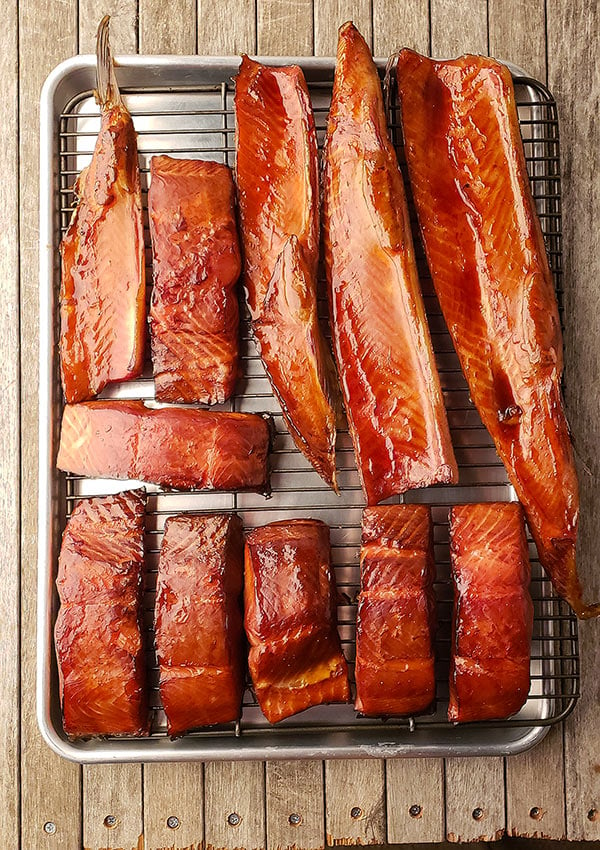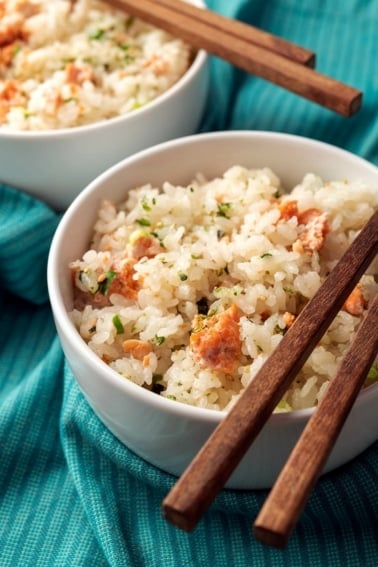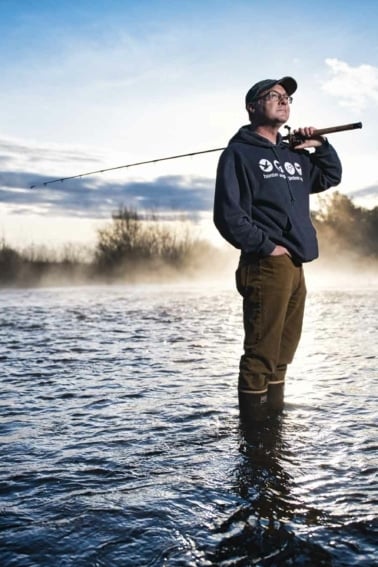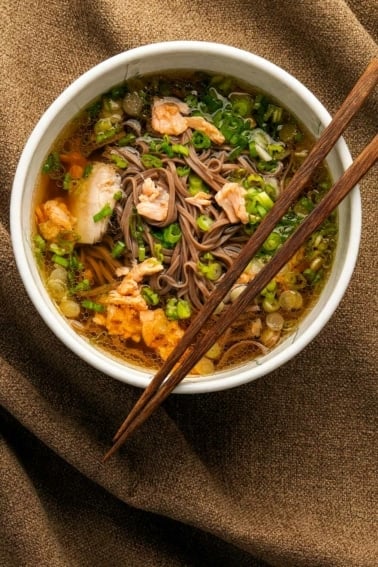As an Amazon Associate I earn from qualifying purchases.

I smoke a lot of salmon, and I am proud of this recipe, although it would be the height of arrogance to say that what I do is the end-all, be-all of salmon smoking recipes. Lots of people smoke their salmon in lots of ways, and many of them are good. But I’ve been smoking fish for many years, and I’ve developed a system that works well.
Keep in mind this is a hot-smoking recipe. Cold smoking, which is the kind of slice-able smoked fish you get in fancy boxes from Scotland is an entirely different thing.
Almost everyone in Salmon Country hot smokes their fish. If you’re unfamiliar with hot-smoked fish, think about those golden smoked whitefish you see in delicatessens; those are hot smoked.
How do you eat it? Well, you can just eat it plain, or you can flake it and make it into a smoked salmon salad, you can pound it with butter and make salmon rillettes, serve it in deviled eggs, tossed with pasta… you get the point.
Here’s what you need to get started:
- A smoker. I’ve uses a Traeger and a Bradley. Both are good. No matter what smoker you use, you will need to be able to a) know your smoking chamber’s temperature, and b) control the heat, at least in a rough sense.
- Wood. The only downside to a Traeger smoker is that you need to use their wood pellets. As a guy who used a Brinkmann wood-fired BBQ for years, fueling it with scraps of almond and other fruit woods, buying wood can be annoying, but you get better precision with this method. I prefer to use alder wood for my salmon, but apple, cherry, oak or maple work fine.
- Salt. Buy a box of kosher salt from the supermarket. Do not use regular table salt, as it contains iodide and anti-caking agents that will give your salmon an “off” flavor. I use Diamond Crystal, which is cut finer than Morton’s.
- Something sweet — salmon love sweet. I prefer to sweeten my smoked salmon with birch syrup; It’s just like maple syrup, only tapped from birch trees instead. Super cool stuff. But maple syrup is just as good. Just use real maple syrup, OK? Not the imitation crap. Honey works, too.
- A large plastic container. Buy the big, flat ones from the supermarket. They stack easily in a normal fridge, so you can have two different brines going. And they clean easily and are pretty cheap.
- A wire rack. You need to rest your brined fish on a rack with plenty of air circulation to form the all-important pellicle (more on that in a bit), and you will use it to rest the smoked fish before storing it.
- A basting brush. You probably already have this in your kitchen, but if not, pick one up. Get the flat kind, like you use to paint detail on window trim.
When you are ready to start, you will need smallish pieces of salmon about 1/4 to 1/2 pound each. Any salmonid fish will work with this recipe. I’ve done it with king salmon, sockeye, coho, and pink salmon, dolly varden, plus kokanee, steelhead and Lahontan trout.
There is no reason it would not work with chum salmon or any other char or trout species. And yes, it works with farmed Atlantic salmon, but I never eat the stuff.
I prefer to smoke salmon with its skin on, but I’ve done it with skinless pieces and it works fine.
Smoked Salmon
Ingredients
- 5 pounds salmon, trout or char
- Birch or maple syrup for basting
BRINE
- 1 quart cool water
- 1/3 cup Diamond Crystal kosher salt, about 2 ounces of any kosher salt
- 1 cup brown sugar
Instructions
- Mix together the brine ingredients and place your fish in a non-reactive container (plastic or glass), cover and put in the refrigerator. This curing process eliminates some of the moisture from the inside of the fish while at the same time infusing it with salt, which will help preserve the salmon.
- You will need to cure your salmon at least 4 hours, even for thin fillets from trout or pink salmon. In my experience, large trout or char, as well as pink, sockeye and silver salmon need 8 hours. A really thick piece of king salmon might need as much as 36 hours in the brine. Never go more than 48 hours, however, or your fish will be too salty. Double the brine if it's not enough to cover the fish.
- Take your fish out of the brine, rinse it briefly under cold running water, and pat it dry. Set the fillets on your cooling rack, skin side down. Ideally you'd do this right under a ceiling fan set on high, or outside in a cool, breezy place. By "cool" I mean 60°F or cooler. Let the fish dry for 2 to 4 hours (or up to overnight in the fridge). You want the surface of the fish to develop a shiny skin called a pellicle. This is one step many beginning smokers fail to do, but drying your cured, brined fish in a cool, breezy place is vital to properly smoking it. The pellicle, which is a thin, lacquer-like layer on top of the fish, seals it and offers a sticky surface for the smoke to adhere to. Don't worry, the salt in the brine will protect your fish from spoilage. Once you have your pellicle, you can refrigerate your fish for a few hours and smoke it later if you'd like.
- Start by slicking the skin of your fish with some oil, so it won't stick to the smoker rack. Know that even though this is hot smoking, you still do not want high temperatures. Start with a small fire and work your way up as you go. It is important to bring the temperature up gradually or you will get that white albumin "bleed" on the meat. I can control my heat with my smoker, so I start the process between 140°F and 150°F for up to an hour, then finish at 175°F for a final hour or two. NOTE: What my smoker is set at is not necessarily what the actual temperature is. Smoking is an art, not a science. To keep temperatures mild, always put water in your drip pan to keep the temperature down. If your smoker is very hot, like a Traeger can get, put ice in the tray.
- After an hour in the smoker, baste the fish with birch or maple syrup, or honey; do this every hour. This is a good way to brush away any albumin that might form. In most cases, you will get a little. You just don't want a ton of it. Even if you can't control your temperature this precisely, you get the general idea. You goal should be an internal temperature of about 130°F to 140°F. (Incidentally, yes, I keep the smoke on the whole time. I don't find this to be too much smoke, but if you want a lighter smoke, finish the salmon without smoke or in a 200°F oven.)
- You must be careful about your heat. Other than failing to dry your salmon long enough, the single biggest problem in smoking salmon is too high heat. If you've ever seen salmon "bleed" a white, creamy substance, that's a protein called albumin. If you see lots of it, you've screwed up; a little is normal. Here's what happens: If you cook a piece of salmon at too high a heat, the muscle fibers in the meat contract so violently that they extrude albumin, which immediately congeals on the surface of the fish. It's ugly, and it also means your salmon will be drier than it could have been. You prevent this with a solidly formed pellicle, and by keeping your heat gentle. If you let your heat get away from you and you do get a white mess on your salmon, all is not lost. Just flake it out and make salmon salad with it: The mayonnaise in the salad will mask any dryness.
- Once your fish is smoked, let it rest on the cooling rack for an hour before you put it in the fridge. Once refrigerated and wrapped in plastic, smoked fish will keep for 10 days. If you vacuum-seal it, the fish will keep for up to 3 weeks. Or freeze your fish for up to a year.
Notes
Nutrition
Nutrition information is automatically calculated, so should only be used as an approximation.







Prior to your recipe I could not get the wife and kids to eat my smoked salmon. Now they can’t get enough of it. I too use a Bradley and really enjoy this recipe.
Thank you for posting this recipe!!! I used my Weber charcoal smoker for the first time this weekend and it was awesome! I followed this recipe exactly except that I used maple syrup instead of birch syrup. I was worried about keeping the temperature where I needed it to be since I was using charcoal but it worked out fine. I didn’t even get any albumin bleed 🙂 I did baste it every hour which probably helped. Even my extremely picky kids who hate fish couldn’t get enough! I made 3 pounds this time since it was my first time – next time I plan to at least double it. Thank you!!!
Advice on the freezer burned fish: If you run the fish under warm water while it is still frozen and use a vegetable brush to scrub the surface, all the freezer burned meat will separate and wash off. This works for freezer burn on many foods. Just perform the action very quickly. You don’t want the remaining fish to have time to thaw while it is under water. It is likely that if you don’t get the freezer burn off before you start to use it, you will still taste the bitterness no matter what else you do to it…
Hank – for a beginner / green horn lick myself, I really enjoyed your recipe basics and advice with the heat smoke method. I will trying my hand with it this week-end. 5 lbs each Chinook and Silver salmon are on my to do list. Any final advice for the brine times? I think the 30 hour rule sounds about right, from what I have just read. Thank you…
Chris
Hank, love your site! In my experience with brown sugar and wild meats is the darker the better. I’m new to fish, does the same hold true?
Pretty much. I like dark brown sugar best.
Hi!
i would love to try this recipe. I am still a bit confused about the brine. Do you mix all the ingredients “in” in the water, stir up thereby creating a brine solution and add the fish to the brine solution to soak?
Thanks!
Good answer! Especially the part about letting the fish return to room temperature. That’s what could have gone wrong – cold fish would be processed by the smoke quite differently than warmer fish – ideally, it might be best to warm it to approximate smoking temperature in the oven before returning it to the smoker. Thanks.
I’ve bookmarked your site – best advice I’ve had on smoking salmon. Most recipes are way too salty for a start.
I have a question. I smoked some fairly thick Sockeye until late at night, but still not done. Decided to bring it inside – a rodent could get into the smoker through the air intake – didn’t want to take the chance. Then put it in the fridge. Question is, would be ok to take it out of the fridge and back in the smoker to smoke it another three hours? I can’t see why not, but it seems there could be a reason not to. Thanks if you have an idea on this.
Yep. You should be fine. I’ve done that before. Let the fish return to room temperature before you put it back into the smoker though.
This is a really good recipe. I was not able to find the Alaska Birch Syrup or any other birch or maple syrup, it is difficult to find it in Europe, partially by adding more brown sugar partially by adding honey.
This worked fine!
We have a large brick made smoker it is difficult to control the smoke temperature in there we just followed it. Started at 176F for about an hour and then smoking for 5 hours at about 140F.
Thanks for pointing out importance of drying the cured salmon I was not aware of it!
Thanks for this recipe!
Also online at Kahiltna Birchworks to make direct calls to order.
Yep. That’s where I get mine.
For those interested you can get Kahiltna Birch syrup from Alaska Wild Berry Products
I’ve been living in Prince William Sound all summer, and have a bunch of sockeye salmon. Unfortunately, my vacuum sealer stopped sealing properly and a fair amount got freezer burned. I was thinking of smoking the freezer burned stuff in hopes of salvaging it. I’m sure it wouldn’t be as good as properly frozen salmon, but do you think that’d still be edible?
Just found your website, and am now very excited to try out all your fish recipes when I get home!
It will be edible, but I’d mash it all up and make rillettes or pate with it.
Can you smoke salmon after it has been frozen?
Cheers Melani
Yep. I do it all the time.
Smoking really is an art. My husband smokes salmon for us in our bbq. I make the buttery crepes. Our li’l sweetheart gobbles it all up. The home-smoked stuff is so delicious that I have a really hard time buying the smoked salmon from the stores. Love your recipe. Going to pass it on to Shawn to try. But first, I have to find birch syrup.
I just bought a Bradley 6 rack smoker. The lowest temperature setting is 120° so that’s where I started the first 2 hours after drying the Red Salmon for 6 hours with a fan blowing cool air over the fish. The highest temp I used was 140 over 6 of smoking. The fish came out moist and very tasty but I had albumin or some other whitish substance all over the fish. Any ideas?
Hard to say. Sometimes it just happens. I brush away any albumin by painting on the maple syrup.
Can the brine be used more than once
I never do. There are apparently health risks, from what I read. Exactly what those risks are I don’t know, though.
Thank you so much for this wonderful recipe! This is a favorite around the household here!
I used your maple syrup recipe to smoke 5 lbs of Alaska salmon. I found that I needed to double the recipe to fully cover the salmon. Will this give me the same taste as using a smaller amount of brine? The proof of how good it was. My grandchildren, who never eat fish, couldn’t get enough of this. I did brine for 24 hours and found that to be not quite enough so next batch will try 36 hours. Do you have other smoking recipes to share?
I have not been smoking stuff for long and only have the “baby” Bradley countertop smoker. But whole salmon was for sale and I could not resist which is how I ended up with your recipe.
The countertop smoker does not allow the slow increase in temperature you describe but it heats up slowly. Although the salmon bled a little albumin it is still nice and moist and … OMG! This is the best hot smoked salmon I have tasted.
Page is bookmarked, I’ll be back! Thanks for this wonderful simple and tasty recipe.
This is the first time I am trying to smoke salmon. My “practice” salmon (or sacrificial salmon) is a nice side of Atlantic salmon from the Costco. If it doesn’t turn out good, it’s no great loss. Your brine recipe and directions look very easy. The salmon is brining in the ‘fridge right now and I will smoke it tomorrow using alder wood in a propane powered box smoker (Iron Forge).
My question is, does it matter that the salmon is skinless? I did not notice this until I got it home from the Costco.